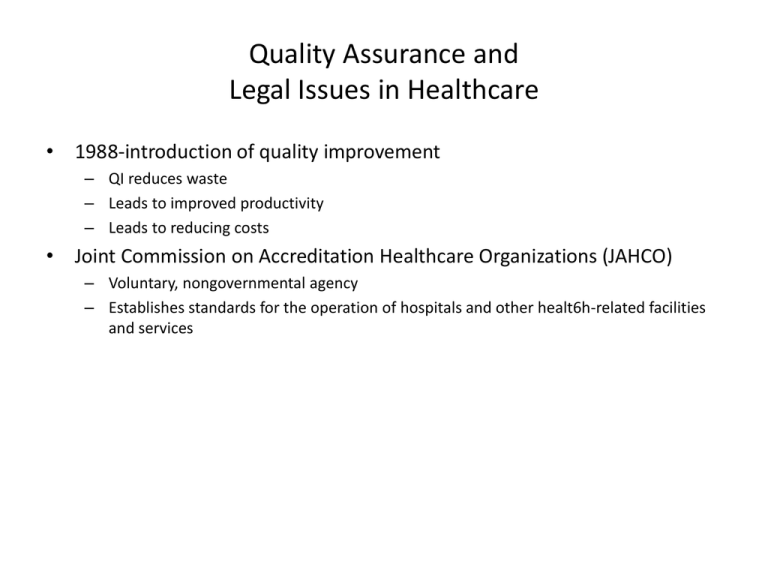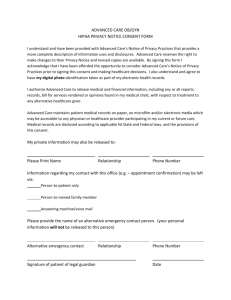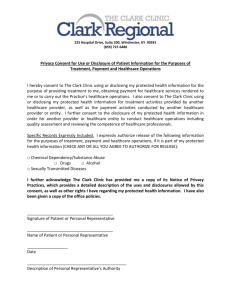Quality Assurance and Legal Issues in Healthcare
advertisement

Quality Assurance and Legal Issues in Healthcare • 1988-introduction of quality improvement – QI reduces waste – Leads to improved productivity – Leads to reducing costs • Joint Commission on Accreditation Healthcare Organizations (JAHCO) – Voluntary, nongovernmental agency – Establishes standards for the operation of hospitals and other healt6h-related facilities and services Quality Assurance and Legal Issues in Healthcare • Clinical Laboratory Improvement Amendments of 1988 (CLIA) – Federal regulations administered by the Center for Medicare and Medicaid Services (CMS) – Established quality standards that apply to all facilities, including clinics and physicians offices that do laboratory testing – Three categories of testing based on difficulty and degree of risk of harm to patient if test is performed incorrectly • • • Waived complexity Moderate complexity High complexity • National Committee for Clinical Laboratory Standards – – – – International , nonprofit, educational organization Representatives from the profession, industry, and government Develop voluntary guidelines and standards for all areas of the laboratory Phlebotomy program approval and certifications exam questions based on guidelins and standards Quality Assurance and Legal Issues in Healthcare • National Accrediting Agency for Clinical Laboratory Sciences (NAACLS) – Non profit – Provides either accreditation or approval for clinical lab education programs – Approval process includes: • • • • On site peer evaluation Whether the program meets certain educational standards (competencies) Designed to improve student outcomes Maintain quality educational experience • Quality Assurance in Phlebotomy – Pre-analytical factors can result in errors in testing • • • Patient preparation Specimen collection procedures Specimen handling procedures Quality Assurance and Legal Issues in Healthcare • Quality Control in Phlebotomy – A component of QA program – Phlebotomist responsibility to check that all operations procedures are performed correctly Areas of Phlebotomy Subject to QC • Patient Preparation Procedures – Starts before specimen collected – Check user manual to prepare a patient • Specimen Collection Procedures – Patient ID most important – Assure quality and sterility of every needle and lancet. Quickly inspect before use. – Check expiration dates on each tube before use – Labeling must be exact – Proper phlebotomy technique using national standards – Know collection priorities such as timed specimens – Perform delta checks Documentation • Medical records – – – – A chronological documentation of a patient’s care Must be accurate and up-to-date Used by physician to develop patient care plan Can be used to communicate between other HCP involved with patient’s care – May serve as a legal document – Assists with total quality management Documentation • The User Manual – A QA document found in nursing units – A chart form of type and minimum amount of specimen required – Includes: special handling, reference values, and normal turnaround time (TAT) • Procedure Manual – Must be available to all lab employees for standardization purposes – States lab policy and procedures that apply to each test – Information in Procedure Manual • • • • • • • • Purpose of procedure Specimen type and collection method Equipment & supplies required Detailed step-by-step procedure Limitations and variable of the method Corrective actions Method validation Normal values and references Documentation • QA Forms – Required by JCAHO to show documentation on all QC checks – Record equipment checks such as refrigerator, incubator temps, centrifuge – Incident reports when problems occur Legal Issues • Divisions of the Law – Criminal Law • Designed to protect all members of society from injurious acts of others • Either felonies or misdemeanors – Civil Law • • • • • • • • • Action between two private parties Torts most common in healthcare Assault Battery Fraud Invasion of privacy Breach of confidentiality Negligence Malpractice Malpractice • Associated with any professional misconduct • Must use standard of care – Have a duty to protect patients from harm – All healthcare professionals perform duties in any other reasonable person with same experience and training • Respondeat superior – Employers are liable for actions of employees even if the employee is at fault • Vicarious liability – Injury occurs as result of a negligent act committed by an independent contractor, the hiring healthcare facility that hired the person is liable • Malpractice Insurance – Necessary if employer may give insurance company right to recover damages from an employee who is found to be negligent Avoiding Lawsuits • • • • • • • • • • Acquire informed consent Respect patient’s right to confidentiality Strictly adhere to procedures and practices Use proper safety containers and devices Listen and respond appropriately to patient’s request Accurately & legibly record all info concerning patient Document incidents Participate in continuing education Perform at standard of care Never perform procedures that you are not trained to do Patient Consent • Informed consent – – – – – Voluntary permission for a procedure, test, or medication Must tell patients all risks and consequences involved before consent given Information must be in terms patient understands Interpreters may be needed Blood collection on minors or mentally incompetent requires parent/guardian consent • Expressed consent – May be given verbally or in writing




